We are working on another Horizon that is in need of a strut alignment. This vessel has a cutless bearing in the forward end of the stern tube, an intermediate strut and a main strut. With three bearings supporting the shaft, the need for an accurate alignment increases. The minor bends in the shaft when the intermediate bearing is out a small amount will cause vibrations at the higher RPMs. In this case, both port and starboard intermediate struts were out of alignment to the tube and main strut. Realignment of these struts is not a huge job if the shafts are removed. The strut bolts have very good access and since it is only the small intermediate strut it is relatively light and easy to handle. As with all strut alignments, it starts with adding jacking screws to the corners of the pad and threaded rod in the strut bolt holes. Using the Optical Scope Alignment system , we can align the strut within a few thousandths of an inch.
Once the strut is in place, a solid bedding compound locks it permanently to the bottom of the hull. Finally, drill the strut bolt holes and bed them in 5200 to finish the job.
A strut alignment is not a big job if done when the shafts are out. Next time you need to have routine maintenance on your running gear (replacement of cutless bearings and shaft seals) make sure you work with a company that is an expert with running gear. Hiring a specialized expert will gain you the extra repair items that the average mechanic might miss.
You might be surprised to find out that a small vibration can be cured and is not just ordinary. Give us a call and we can talk about more details on your next project.
High Seas Announces the Launch of a New Division – High Seas Hydraulics
Today we officially announced our new division dedicated to servicing all types of marine hydraulic systems – High Seas Hydraulics.
For many years our running gear business has worked close to hydraulic systems. With a growing demand for hydraulic service we decided to launch a new division by hiring hydraulic specialists and open a new facility at Lauderdale Marine Center. The new facility includes air conditioned space for rebuilding hydraulic cylinders and building Parker hoses.
More details on our services are included in the High Seas Hydraulics press release and stay tuned for more information on our broad range of hydraulic service capabilities.
Class ABS and Lloyds Rudder Bump Test
Vessels falling within this class are required to have a rudder bearing clearance inspection every five years. However, we find more and more often that surveyors are asking for this data every time the vessel is hauled. The good news is a rudder “bump” test will give sufficient information to avoid the cost of completely removing the rudders. The simple 15-minute test (which measures lower bearing wear) can be performed anytime a yacht is hauled. However, in order to minimize down-time, it is important the test be conducted as soon as possible after hauling to provide enough time for parts ordering and the completion of repairs if the test reveals excessive wear. Note, even if the inspection is done before the five-year survey, ABS and Lloyds requires a repeat examination during the survey. The most notable signs of excessive wear are vibration and leakage around the lip seals.
How the Test is Performed
A stanchion (usually a yard jack stand) is raised to the bottom of the vessel directory abeam of the rudder post to create a stationary benchmark. Using a dial gauge affixed between the post and stanchion, lateral pressure is applied to the bottom of the rudder flag to check for athwartship movement, the most common bearing wear is athwartship (not fore/aft), due to the greatest hydraulic forces. Rudder bearings come in a variety of flavors; bronze, cutlass, Thordon, Tides or other phenolic material. Acceptable wear varies based on the 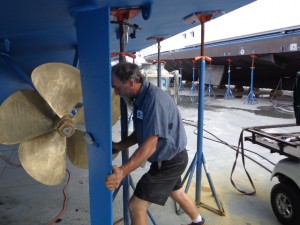 material, but typically bearing wear which exceeds .030” (3/4mm) indicates excessive wear and must be replaced. The same test is performed after the stanchion is moved fore or aft of the post.
material, but typically bearing wear which exceeds .030” (3/4mm) indicates excessive wear and must be replaced. The same test is performed after the stanchion is moved fore or aft of the post.
When your surveyor asks for a “Rudder Bump Test” don’t worry – the test is fast, simple and painless. If you are in Lauderdale Marine Center we can knock it out on short notice.
Propeller Crack Testing – A “NEW” ABS Class Requirement
Earlier this year, ABS implemented a new survey requirement when a vessel is hauled for propeller work. Each time a propeller is removed and reinstalled, the entire hub of the prop should be crack tested on the vessel. The concern is that repeated torqueing of the prop hub onto the shaft taper may induce cracks.
Regardless of a vessel’s size, its propellers experience exceptional cyclic stress and fatigue. The stress can eventually result in cracks, both visible and microscopic. The fragmentation of a wheel while underway can have numerous consequences including the delay of a trip, damage to the vessel, or in rare cases, personal injury. A skipper or owner can mitigate these problems with a crack test that will detect defects before they become a bigger problem.
The red dye penetrant test is the preferred non-destructive procedure for crack testing a propeller. Depending on the volume of area to be tested, it usually can be completed within a few hours.
Although many yards or mechanics can apply dye penetrant and developer to a propeller, the skill, knowledge, and expertise truly exist in a technician’s ability to interpret the results. The ability to understand each nuance of a dye pattern can be the difference between unnecessarily replacing a wheel; or worse, not replacing one. Owners, captains, and engineers are wise to use only class ABS and Lloyds Certified level two facilities.
High Seas and Straight Line Marine is a certified Level II crack testing facility. Give us a call if you are going through an ABS survey or just want to check your props for peace of mind.
While many captains and engineers are familiar with propulsion shaft cladding Propulsion Shaft Cladding, few know that cladding techniques are also applicable on rudder stock. The stock, less the flag is lathe turned to provide the optimal surface for cladding. After the removal of defective metal, the stock is built-up (cladded) to exceed the diameter of the stock on either side of the cladded area. Afterwards, the stock is returned to the lathe to remove the precise amount of cladding to make the stock uniform in diameter and without a detectable seam at the repair. The finished product is a stock which is as good as new.
Detection of Rudder Stock Problems
With a wet vessel, the sight of moisture around the stock is an indication of a problem with the stock, bearings, seals, bushings, or all. For a dry vessel, the accumulation of salt around the stock is the telltale sign of seawater intrusion. From the exterior of a hauled vessel, the “rudder bump test” is a simple, but effective diagnostic. The amount and type of “play” indicates that some or multiple items are worn and needing service. Side-to-side play is a sign of lower bearing wear. Twisting play means that pins, bushing, and joints in the tiller arm require service.
Replace or Clad
Frequently, the question posed is whether to replace or clad. The answer is simple…time, money, and quality. The typical time to clad or replace is days versus weeks. The cost for cladding is about 80% less, and the finished product is every bit as serviceable as a new replacement. With reduced costs, high quality, and much faster turnarounds…cladding is the preferred choice.
Straight Line Marine is the only machine shop in Florida that is approved by ABS for Cladding on ABS class vessels. ABS Announcement Article
Any vessel that is in “Class” (Llyods, ABS…) requires a five year shaft survey. That survey includes crack testing of the shafts and propellers in a machine shop. However, not everyone who does crack testing should be doing crack testing. Proper testing requires a highly skilled and trained technician. This is why Lloyds requires Level II certification for machinists to perform crack tests on Llyods class vessels. Level II technicians have been trained on the proper procedures and how to interpret the results. There are very few machine shops in the marine industry who have earned this difficult certification for shaft work.
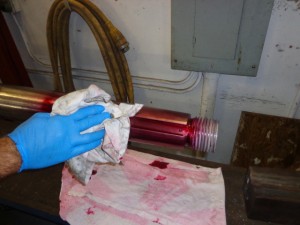 I am often asked, “What makes testing so specialized and difficult? Doesn’t the technician merely clean the shaft and then coat it with a dye followed by a developer?” Actually, crack testing uses a dye penetrant process that allows hairline cracks to be seen by the human eye. A specialized red dye is sprayed onto a cleaned area of the shaft – usually the prop and coupler tapers. Once dried, the surface dye is removed by a specialized solvent. If there is a crack, small amounts of the dye will remain down inside the crack. The next step involves spraying a developer in the same area. The developer quickly dries to a white powder and wicks the red dye out of the crack. A crack will show up as red dye in the white powder. Although the process sounds simple enough, the dye appearing in the powder can have varying meanings. This is where the training, experience, and certification come into play. The technician must be able to correctly “interpret the results” of dye testing. In NDT (nondestructive testing) the dye test may indicate what appears to be a crack; however in reality, it is only an imperfection and not a crack.
I am often asked, “What makes testing so specialized and difficult? Doesn’t the technician merely clean the shaft and then coat it with a dye followed by a developer?” Actually, crack testing uses a dye penetrant process that allows hairline cracks to be seen by the human eye. A specialized red dye is sprayed onto a cleaned area of the shaft – usually the prop and coupler tapers. Once dried, the surface dye is removed by a specialized solvent. If there is a crack, small amounts of the dye will remain down inside the crack. The next step involves spraying a developer in the same area. The developer quickly dries to a white powder and wicks the red dye out of the crack. A crack will show up as red dye in the white powder. Although the process sounds simple enough, the dye appearing in the powder can have varying meanings. This is where the training, experience, and certification come into play. The technician must be able to correctly “interpret the results” of dye testing. In NDT (nondestructive testing) the dye test may indicate what appears to be a crack; however in reality, it is only an imperfection and not a crack.
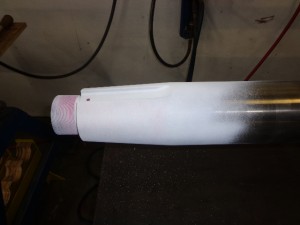 As cracked shafts are not repairable, a misdiagnosis would result in discarding a perfectly good shaft. Unfortunately, sometimes the opposite is true. What a technician thinks is only a surface imperfection is actually a serious structural flaw. Once again, the improper diagnosis would result in an otherwise avoidable expense. It requires incredible skill, knowledge, and experience to “call it” correctly. As such, the best means to save money and protect against unnecessary expense is to select a certified, full-service shop. Most captains and engineers agree that the selection of a facility that meets Llyods and ABS certification requirements is a no-brainer.
As cracked shafts are not repairable, a misdiagnosis would result in discarding a perfectly good shaft. Unfortunately, sometimes the opposite is true. What a technician thinks is only a surface imperfection is actually a serious structural flaw. Once again, the improper diagnosis would result in an otherwise avoidable expense. It requires incredible skill, knowledge, and experience to “call it” correctly. As such, the best means to save money and protect against unnecessary expense is to select a certified, full-service shop. Most captains and engineers agree that the selection of a facility that meets Llyods and ABS certification requirements is a no-brainer.
The typical questions I get when a crack is detected are:
How bad is the crack…How deep is it…How long will my shaft last?” Regardless of who asks the question, my answer is always the same, “It depends upon how much you are willing to gamble.”(I think most people agree that Murphy always shows up at the worst possible time). If you are in the middle of the Gulf Stream and your shaft breaks, at a minimum you can say goodbye to your propeller (and if you are really lucky, the prop won’t punch a hole in the bottom as it spins uncontrolled off the shaft). So, besides losing a screw worth many thousands of dollars (now a permanent fixture on the ocean floor), you’re also probably in the middle of nowhere. The final answer is – a cracked shaft must be replaced.
The next time you are up for a shaft survey, select a company that has all the right qualifications in-house. High Seas Yacht Service will do all of the mechanical work, alignment work and shaft machine shop work, including in-house, Level II crack testing.
Tis the Season for working on torsional couplings. This particular unit came out of a 75′ Sunseeker with a ZF V-drive and Cardan shaft configuration. Similar to the last post on Vulkan Couplers, this unit is attached to the flywheel and designed to take the various torsional loads that are transferred between the drive-line and engine.
The Captain had a concern with vibration on one engine and an alert engineer noticed the movement right at the Cardan shaft u-joint. The u-joint was fine; the movement was from the play in the center bearing and outer “roller” elements of a Centa CF-RV coupling.Once the Centa coupling was removed and disassembled it was clear that the center bearing was damaged and the roller elements were worn. The urethane roller elements (hockey pucks) disperse the torque loads by gradually compressing as the inner assembly torques in the housing (see picture).How can this failure occur? With many of our projects we are able to make a determination as to the root cause of a failure. Just replacing a bearing and sending the customer on their way is not enough. We checked the cardan shaft alignment (engine to remote ZF) and it was good. Apparently this engine had been rebuilt some time ago and an engine alignment took place at a later time. We can only speculate that the initial engine rebuild mechanic left the engine out of alignment and the bearing was damaged from u-joint loading. Once damaged it gradually wore the roller elements and continued to wear the inner bearing.After sea-trial the customer was happy. We made his short turn-around schedule which made the “boss” (owner) happy, to keep on schedule and use the boat.We are very familiar with most CentaFlex Torsional couplings systems. Please give us a call if you notice some play in the Cardan shaft bearing area.
Vulkan coupler are one of the most common found on mega-yacht sized vessels. This torsional coupling is found between the gear box and the engine and serves to dampen the torsional loads coming from the engine flywheel. A polyurethane element (see second photo) acts as a gear “bumper”. This particular Vulkan model was removed from a 87′ Ferretti with a ZF v-drive gear box and a Spicer cardan shaft.
The call first came in when a distinct thump was heard from that engine. The diesel mechanics checked out their end and determined it was int he drive train. That is when we get the call.
It was apparent that something was wrong when you could stand over the engine side of the cardan shaft and lift the assembly slightly – a worn bearing. With this version of a Vulkan there is a large bearing that is part of the bell housing assembly. This supports the weight of the u-joints on the cardan.
The Cardan and Vulkan have considerable weight and were, of course, in some tight places. You could say this job took more brawn than brains.
The job does require the right tools and training. The flanged coupler in the first photo must be removed from the shaft in order to replace the assembly on the housing. The coupler is hydraulically fit on the shaft. To remove and replace requires a high pressure pump and the right fittings. Any other removal process (force, heat) will definitely damage the assembly beyond repair.
Vulkan Couplings – another High Seas Yacht Service specialty.
We are all very proud of the announcement today that Straight Line Marine (a division of High Seas Yacht Service) is now certified for American Bureau of Shipping (ABS) Cladding on Stainless steel shafts. Straight Line is the only machine shop in the State of Florida to be awarded this certification which is a testament to the skill of our master Machinist Chris Zylka.
Shaft cladding repair (otherwise known as a weld-over) is a machine shop process for repairing shafts with layers of welding. The process is explained in more detail in this technical article. When a shaft is worn or pitted with crevice corrosion the surface becomes hostile to shaft lip seals or cutlass bearings. The lip seal will leak continuously while a cutlass bearing will wear out prematurely.
Crevice Corrosion is a chemical phenomena that occurs in warm, stagnant salt water. The chemical properties change with time and corrosively attack the stainless steel. This problem is outlined in more detail in this white paper that explains the chemical reaction and possible preventative measures that a Captain can take.
Prior to Straight Line Marine becoming certified an ABS Class vessel that needed shaft cladding would need to ship the shafts outside Florida. Straight Line Marine will pick-up and deliver shafts in the South Florida area. This will save yachts a tremendous amount of time and money.
Congratulations to Chris Zylka for all of his hard work and accomplishments.
.
Straight Line Marine is a machine shop dedicated to running gear and the art of repairing bent shafts and struts. When looking at bent shafts we often get the question – is it too bent to fix? The answer is simple – if it is not cracked then it can be straightened. A cracked shaft is not repairable (focusing here on stainless steel marine shafts) and must be replaced. A bent shaft can be repaired. We use a cold, hydraulic press process that does not alter the metallurgy of the shaft. It takes a lot of practice and time to straighten a shaft. Some shafts have metal memory and need to be checked hours or a day later. If the shaft is bent badly enough (over 1/2″) we will run a red dye crack test when the straightening is complete. Unlike this experience straightening bronze struts, we have not had a shaft crack during the straightening process.
It is hard to imagine a 4″ shaft bending almost 1.5″ at the prop taper and even more difficult to see in a picture. So here is a quick video showing one of our extreme projects. This shaft was out of a 112′ Westport that ran hard aground.
The bent shaft was not the only damage – the V-Strut legs were “waffled” as it was pushed straight up towards the vessel’s bottom. Straightening both legs took quite a bit of enginuity with a series of hydraulic presses. We did save the strut and reinstalled it with an optical scope alignment.

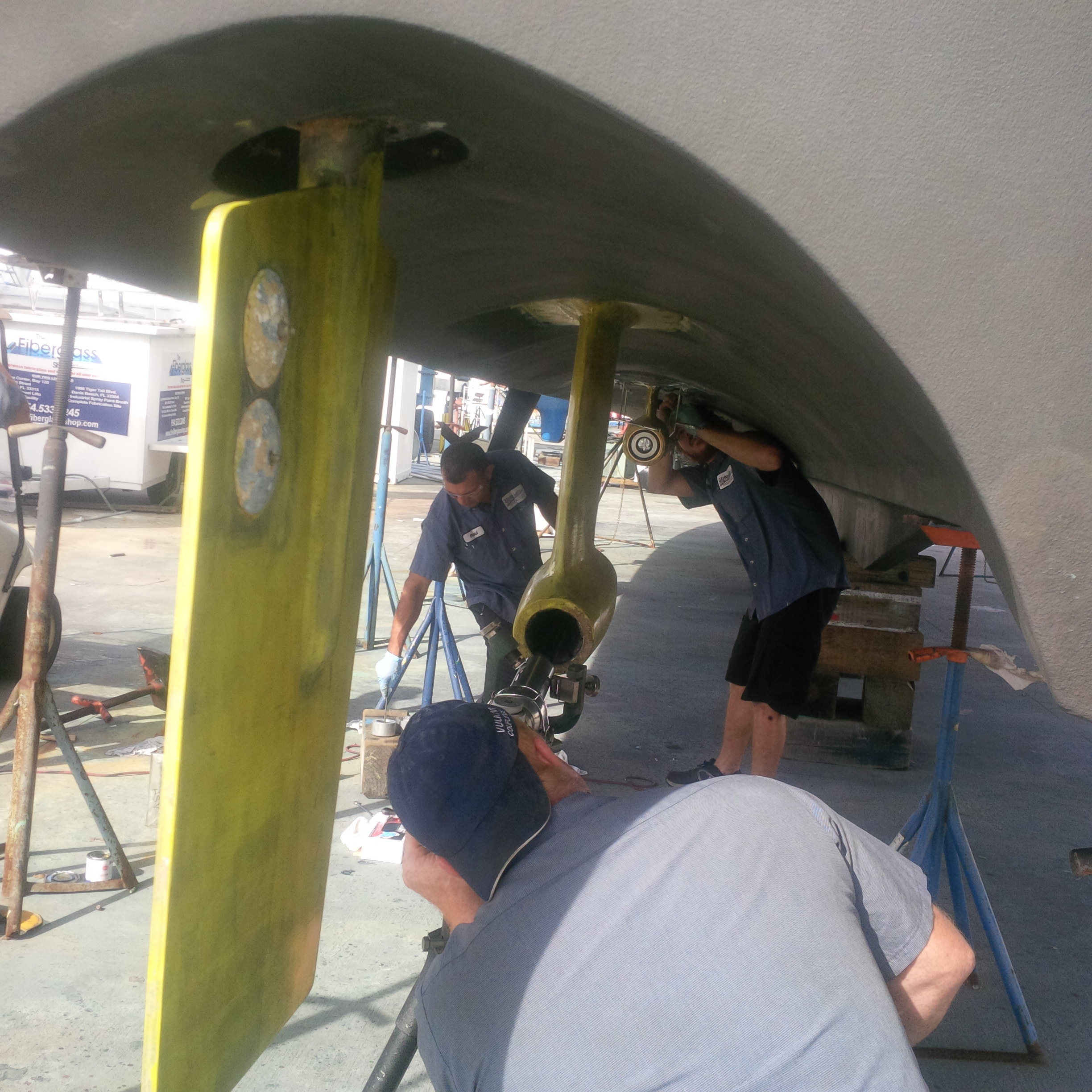
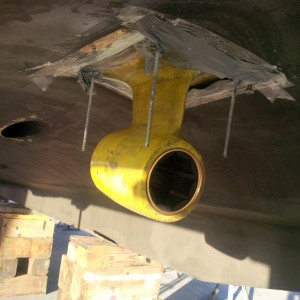
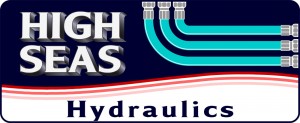
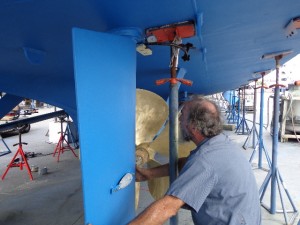


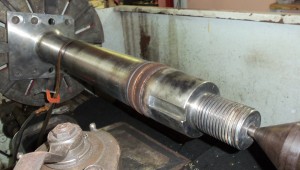
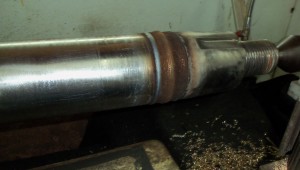
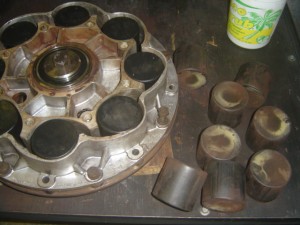
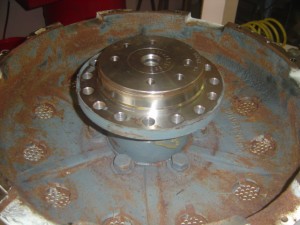

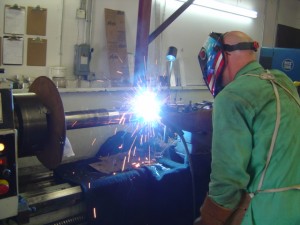

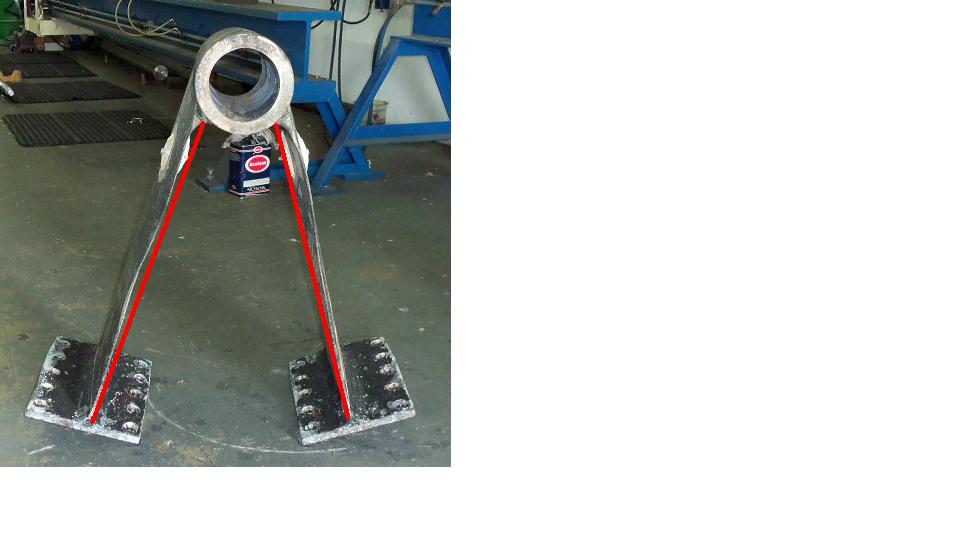
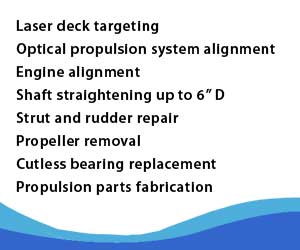
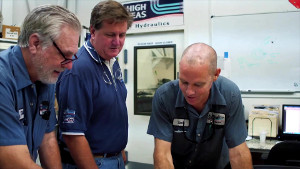 Click to watch the video of a day at High Seas Yacht Service.
Click to watch the video of a day at High Seas Yacht Service.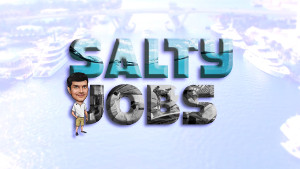 Click to watch Marine Industries Association of South Florida video featuring Salty Jobs at High Seas Services.
Click to watch Marine Industries Association of South Florida video featuring Salty Jobs at High Seas Services.